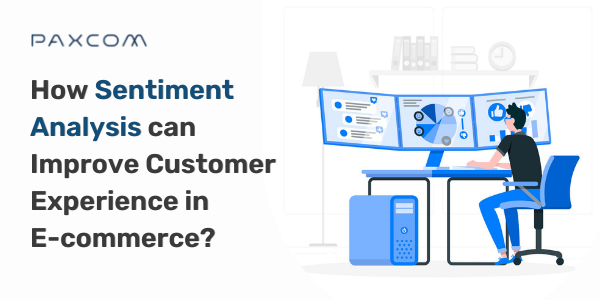Over the years, the e-commerce industry has seen many changes. But one thing that has stayed constant is customers’ reviews and ratings of products.
A study by Zendesk stated that online reviews and ratings have the biggest influence on buying decisions today. One-third of shoppers spend more than three hours a week reading online reviews, and 34% of shoppers say they are more likely to buy from a brand that has more positive reviews.
Wouldn’t it be helpful to find out what consumers are thinking about your product? If you could understand their voice and make it work for you?
Sentiment analysis makes it possible to pinpoint the current problem, thus allowing you to address the issue at the source. It is a technique where you use natural language processing (NLP) OR Machine Learning to infer consumers’ sentiment from their comments/reviews.
Sentiment analysis helps you identify the root cause of negative and positive reviews and allows brands to leverage it by interpreting user emotions and reactions to their products or services. It is an excellent tool for any brand that wants to monitor its reputation, analyze product performance, and improve its services.

Sentiment Analysis used to be exclusive to huge brands, but, with the help of increasing advancements in artificial intelligence and machine learning, it has become accessible to small and medium-sized businesses too. In this blog, we explain sentiment analysis, how it works, and how it can be beneficial to eCommerce brands.
It can be branched out into these categories: rule-based analysis, dictionary-based, and aspect-based analysis. We’d like to give you a short rundown on the technical aspects of this system, then go in-depth on its benefits.
Table of Contents
What are the different categories of sentiment analysis?
(A) Rule-based analysis
Rule-based sentiment analysis is the process of identifying a sentence or a statement as positive, negative, or neutral based on some predefined rules.
For instance, if you find a word, let’s presume ‘attractive’ in a sentence, and if that word appears multiple times in a row within two words of its beginning, then the ML considers it positive.
Based on a logical framework, it is an offshoot of NLP, in which the system tries to deduce the sentiment expressed, as in the example above, from a set of rules that have been programmed into it.
(B) Dictionary-based analysis
Dictionary-based sentiment analysis is a method for identifying positive or negative opinions in text. It uses a dictionary or a set of predefined words and phrases that have been pre-classified either positively or negatively.
This list can be created manually or derived algorithmically with the help of machine learning algorithms. For example, if the word “awesome” appears in a sentence but does not appear in the predetermined list of positive words, that sentence is deemed negative.
(C) Aspect based analysis
Aspect-based sentiment analysis is a type of advanced text analytics that analyzes the overall tone of the text. It focuses on extracting opinions, feelings, and emotions associated with each aspect rather than trying to analyze the complete polarity of the content.
For instance, suppose you wanted to buy juice. The aspect-based approach would tell you if people think the juice is good tasting or not, fresh or not, if the pack is tightly sealed or not, etc. It gives you a more granular understanding of the product/service being reviewed and, hence, can be used for better decision-making.
The image below will help you identify the fundamental difference between various types of sentiment analysis
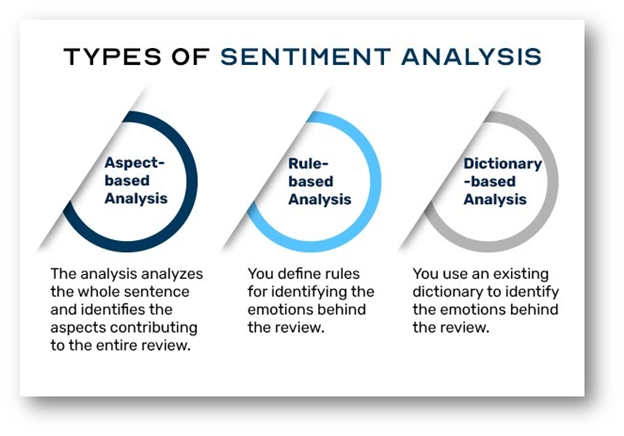
Now you understand how NLP bifurcates sentiments. Let’s get to the exciting part that will surely interest you.
We will be focusing more on aspect-based analysis since that is more relevant and advanced for eCommerce brands.
The aspects machine learning can identify through NLP
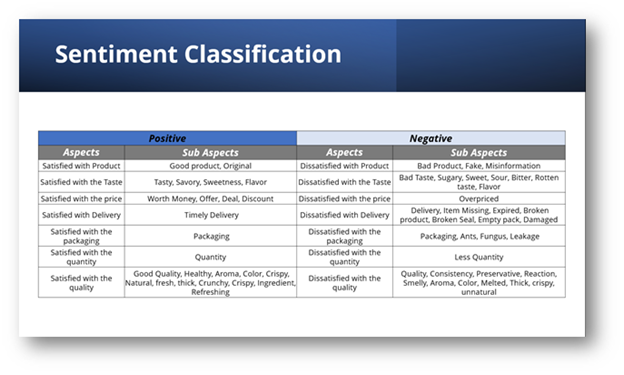
The image depicts how sentiments are classified and how they help identify positive and negative aspects and sub-aspects of the review
- Delivery
- Price
- Product
- Packaging
- Performance
- Quality
- Services
- Taste
Now that we’ve covered the fundamentals and workings of Sentiment Analysis, let’s dig deeper into it:
How brands can use sentiment analysis to improve customer experience
1. Tap into your customers’ minds

We all know that digitization has changed how people shop. Gone are the days of brick-and-mortar. Now there are millions of online shoppers, which means everyone is entitled to have their own set of opinions. So it was observed that when customers are browsing through products, they usually tend to look for top reviews (1st-page reviews) of products and images posted by buyers to make a purchase decision.
In addition, when consumers search for products, they tend to filter their results with at least four or more ratings, because higher ratings have the most trustworthiness behind them, making customers feel more confident in purchasing the product.
Let’s take an example of a giant eCommerce platform, Amazon, which has a review system for writing opinions about products. Then the shoppers can mark the reviews as most helpful, which means that customers read more useful opinions first. This is also something new that brands should consider tracking and taking note of.
In this situation, you can use sentiment analysis data to track where you stand in the market relative to your competitors, identify and correct any inaccuracies, and improve engagement with your customers.
2. Understand customers’ frustrations
The customer decision journey is a framework that helps you identify the emotions and frustrations of customers throughout the purchase journey. Sentiment analysis lets you see why potential customers make their decisions, when they make them, and how your competitors influence them.
Let’s suppose customers’ constant complaint is that the brand is not putting up the complete information on the product page, images portray false information, or the title is incorrect.
You can collate all this data and create a plan to provide your customers with tailored content. You can go above and beyond by adding multiple images, writing a piece of crisp product information to ensure the potential customers are satisfied and the number of complaints is reduced.
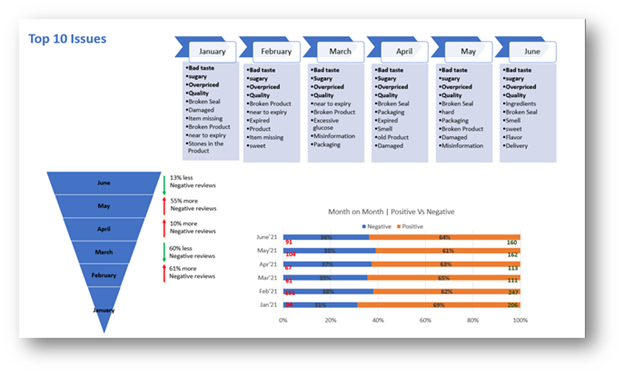
3. Sentiments behind the ratings
The importance of customer ratings has been growing by leaps and bounds. From products to services, everything has a rating that is a reflection of its quality.
It is no longer just about customer satisfaction, but also how they feel about the product. Often, customers don’t have the time to write detailed reviews for a product, which is why the rating sections come in handy to filter the products based on them and help customers make a purchase decision.
Product ratings have quite become a trend, and more and more people leave ratings than comment reviews, so it’s essential to understand their sentiments and emotions.
It can help improve the products and brand performance on your platform. Sentiment analysis allows you to identify problems from multiple channels that could have been overlooked in your development cycle or even identify new growth opportunities.
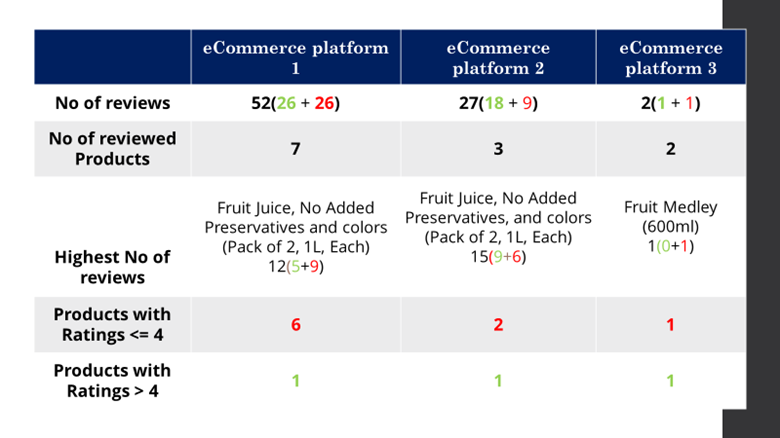
4. Optimize Marketing Strategies
Customer sentiment analysis can help you find customer segments based on their positive or negative feedback. This way, you can design hyper-personalized experiences for them.
For example, customers might feel that you don’t offer enough discounts and coupons. In this way, you can re-adjust your marketing efforts and show them promotions to keep them satiated.
5. Gain valuable intelligence

When machine learning starts tracking customer opinions and feelings, you can leverage this data in your intelligence database. According to data by Naggaro, 45% of early adopters have begun getting increased insights about their customers and competitors because of sentiment analysis to help brands reach their potential business growth and tap into the lucrative eCommerce market with ease.
6. Predict the success of your future launch

With so many brands launching new products and services every day, it isn’t easy to find the right way to market, promote, or launch a new product. It is all about predicting how your customers will feel about your future products.
It sounds like something out of a science fiction novel, but it’s real, and it’s not that hard to pull off. So what does sentiment analysis exactly do in regards to predictive analysis?
It will extract and analyze feedback from all your eCommerce channels and compare that data with previous products’ performance, which can serve as a determining factor for your future products’ success.
Armed with this information, you could take the necessary steps to turn customer sentiments into the success of your product.
7. Improve Response Time to Gain Competitive Edge

Customers today are more demanding, and everyone wants their concerns to be solved within a day, and the number is growing. When brands use every piece of feedback constructively to shape the customer’s journey, it shows that they care about their customers, increasing their likelihood of retaining them. Yes, you read it right. Response time has become of paramount importance.
Just like you can gauge your own performance, you can do the same for your competitors. Knowing what consumers think of your and your competitors’ offerings can help you formulate a strategy that will help identify what is lacking so you can deliver what consumers want.
8. Improve Shipping services

More than 50% of consumers expect delivery within two days, while shipping speed is not the only important factor that affects customer satisfaction. Faster shipping can get your product in no time, but today, customers are also more concerned with their overall experience and how you handle their complaints.
When customers are satisfied, they tend to leave positive reviews and are likely to buy from you again. Here’s how you can make your customers happy with the use of Sentiment Analysis.
It can help you here by identifying and categorizing the attitude or opinion of a customer in regard to their reviews of shipping services. It can be either positive, negative, or neutral. You can better understand customer feedback this way and improve shipping services to retain them.
9. Identify emerging shopping trends
Sentiment analysis identifies the positive and negative emotions associated with a product. This can reveal people’s interests, needs, and complaints, allowing businesses to reach previously untapped customers.
Taking on a new market can help you discover new sentiments and ultimately create a trend line for the product. By doing this, you’ll be able to discover which products or features are most popular across all channels.
10. Brand Reputation Management

The task of improving your brand can be a daunting task. Many factors come into play when you are trying to monitor your brand’s reputation, but how can you see if the changes made are improvements or if they are destroying your brand? The most overlooked aspect of revitalizing a brand is customer sentiment.
Sentiment analysis can be used to find out what people are thinking about your brand. Showing you the areas that require improvement or those that receive positive feedback can help you improve your brand.
For example, if you have a brand store, and people are reviewing that the interface is not pleasing, the information is all jumbled upon, all these shortcomings can be figured out.
The example below shows how you can get information on multiple products in a consolidated form to understand better how you can use sentiment analysis to relaunch yourself in the market.
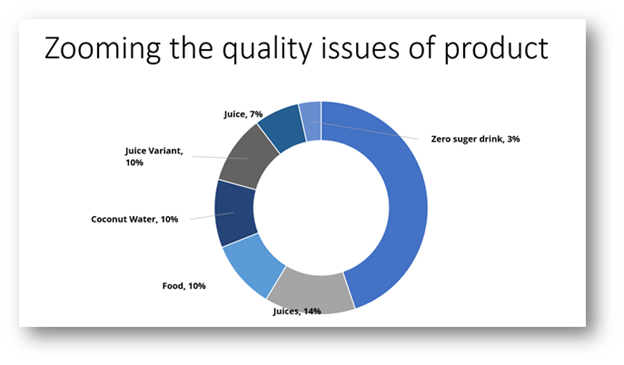
How Paxcom can help you gain valuable intelligence with Sentiment Analysis
Paxcom’s cutting-edge Channel Intelligence solution – Kinator, helps brands consolidate reviews and ratings for their products across all platforms into one place for easy access. The tool summarizes brand, category, and media trends in positive and negative ratings across multiple SKUs.
This report examines the factors leading to positive and negative reviews, identifies areas of improvement, and compares the customer’s experience with that of the competitors. Our eCommerce experts help brands reduce customer churn, gather feedback, and create customized reports to meet their needs.
Analysis capabilities of our inhouse tool (Kinator) in regards to sentiment analysis:
- Comparison with competition across all metrics
- Product ratings: top-rated and bottom-rated
- Top issues with worst-rated products
- Performance comparison between each channel and product
- Verified vs. unverified reviews
- Sizes and variants of packs
- Reviews with images
Bottom Line
To survive in e-commerce, it is important to keep your customers happy. With the increase in competition and the complexity of the customer journey, brands are finding it difficult to stand out.
Sentiment analysis can help you identify and measure different stages of the customers’ purchase funnel-from awareness to post-purchase. Using this data, you can analyze the impact of your existing marketing campaigns, product launches, and online reputation & performance.
Although Sentiment Analysis is a powerful solution, working with experts can help you solve the inefficiencies of the solution while gaining the insights you need to improve your brand perception and customer experience. Connect with us at info@paxcom.net

